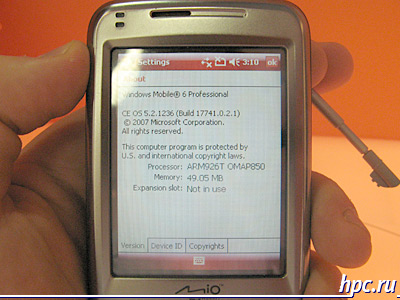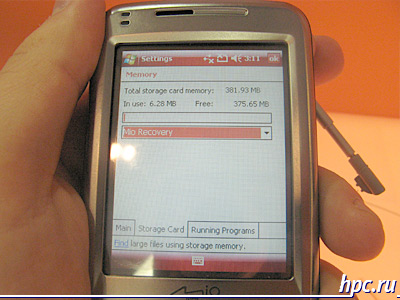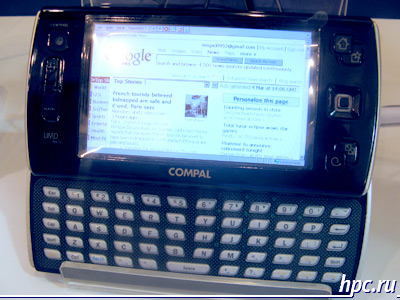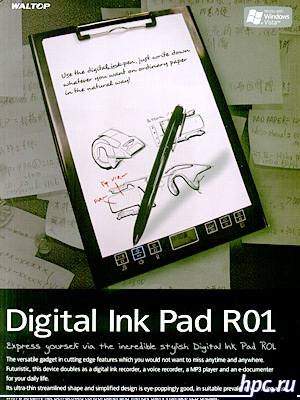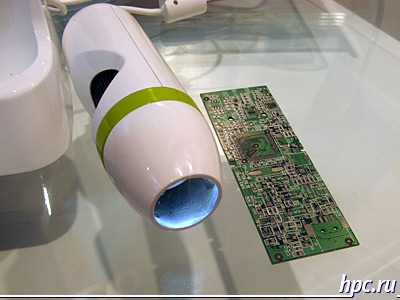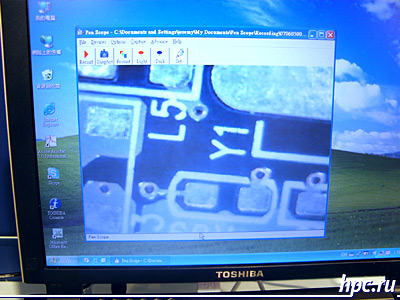OpenMoko and FIC Neo 1973
It has long, very long time since we have not seen interesting new PDAs and smartphones based on Linux. Company FIC back in 2003 to try his hand in the field of handheld devices, offering a range of machines WM Cavalry, and one device is a prototype on Linux. However, no further we have not seen. A new approach to the creation of a competitive modern device company FIC saw in the creation and use of Open Source mobile platform, which is what the funds were allocated and resources. The new platform called OpenMoko (stands for Open Mobile Kommunications - the letter C is replaced by K on purpose) is to provide everyone free and open set of technologies, tools and shells for use on mobile devices. The creation of additional programs and adapting existing software (for Linux) is farmed out to all interested developers. At the same time questions GUI and conceptual devices open mobile platform are solved centrally community OpenMoko. Interestingly, the fundamental decisions are made that way, rather than the traditional scheme, where the work is directed by funding the work of consortia or companies. As conceived by the community OpenMoko mobile system should be like a two-layer - on the one hand understandable and accessible to ordinary users, on the other hand be extremely scalable in terms of enthusiasts. Another idea OpenMoko - an opportunity to work on any device, hardware which, in principle, allows it. That is, in fact, it is likely that in the event of a successful continuation of development, everyone will be able to install (or compile and install:)) OpenMoko instead of Windows Mobile and other mobile OS. And for smaller manufacturers new opportunities to produce communicators without the cost of licensing the operating system. After all, if, say, Windows Mobile value and total number of licenses in the minimal set - a very critical issue. This is partly why no alternative except OEM or selling their own products and technologies to larger companies, many beginners simply do not. The first communicator, which is being debugged OpenMoko and which goes on sale - it's FIC Neo 1973. At the moment, live communicator is quite usable device with excellent quality VGA screen with 128 MB of RAM, a high-quality modern plastic.
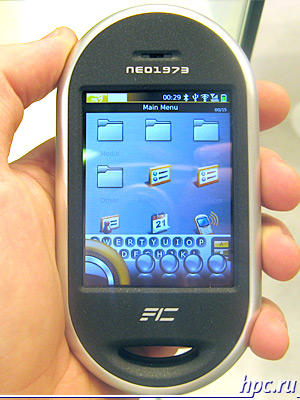 |
| FIC Neo 1973 |
 |
| FIC Neo 1973: external antenna jack, miniUSB, power button |
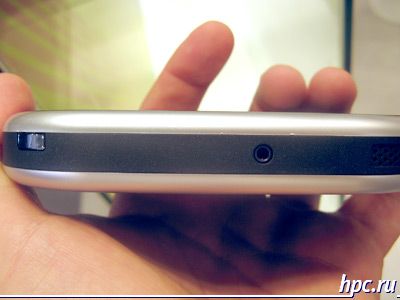 |
| FIC Neo 1973: More button, headset jack |
Features FIC 1973: - Processor: Samsung S3C2410AL-26 266 MHz
- Display: 2.8 "640 x 480 pixels
- Memory: 128 MB RAM, 64 MB ROM
- Memory Card: microSD
- Cellular Networks: 4-band GSM / GPRS Module (support AGPS service)
- Connectivity: Bluetooth, USB-host, (Wi-Fi in development)
- Size and Weight: 120.7 x 62 x 18.5 mm, 184 g
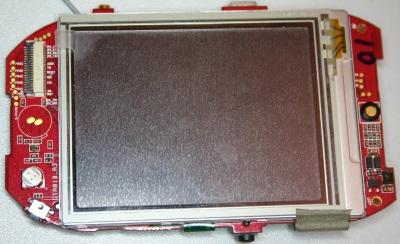 |
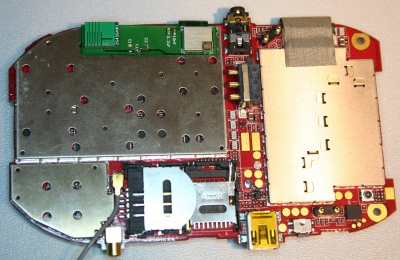 |
Although not the fastest 266 MHz processor Samsung, Shell OpenMoko working without perceptible delay. At this stage, all the states full operability of the PDA, modules, GPS, Bluetooth and GSM, made in the form of standard daemons (daemon). According to one of the leading developers currently are working on adding to the OpenMoko modules to work with WiFi. The ultimate (end-user) price sought by the manufacturer, should be about 350 USD (abroad). Let's see, there will be enough OpenMoko energy and resources to compete with commercial platforms. However, in itself, the project is extremely interesting, and probably has all chances to become an event in our region, if the device based on OpenMoko will reach the shelves in stores. Meanwhile, representatives of the FIC promise that the device will appear in the online sale has "very soon". However, the delay from the original plan to launch sales of the past six months. And while everyone can see the OpenMoko details or even try the system on the emulator, only want to warn that the emulator is absolutely not transmit real feeling of using your device, ROM it almost does not contain built-in programs. And the emulator is intended primarily for developers for debugging.
Mitac Mio A702 and Mio A501
Mitac company showed two new products: GPS communicators Mio A702 and Mio A501. About Mio A501 model, we have previously mentioned, the device was demonstrated, inter alia, at CeBIT.
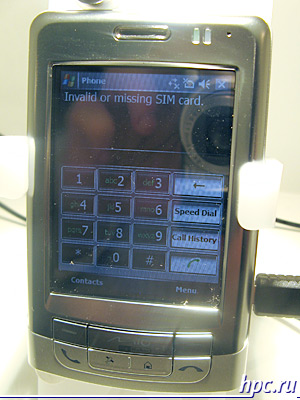 |
| Mio A501 |
As previously reported, the new model is significantly different from its predecessors - the communicator Mio A700/A701, however, remained the main feature - emphasis on the GPS-functions. In this case, change the form factor, Mio A702 is equipped with not only the navigation keys, but also convenient numeric keypad, which is extremely convenient to work "by feel". The lower edge of the buttons appear and well defined fingers. Also improved built-in camera - it has a resolution of 3.2 megapixels and supports auto-focus. New works under the new operating system Windows Mobile 6. Processor - OMAP 850 (and not XScale), Memory exhibition copy is 64 MB RAM and 384 MB of ROM (a not 128, as previously assumed), the diagonal of the display is 2.7 inches, and resolution - QVGA (320x240 pixels). Expansion memory card can format microSD. Differences from Mio A700/A701 - a built-in Wi-Fi module, in addition to supporting the cellular networks and interfaces Bluetooth. As for GPS-functions, the novelty supports new technology SiRFDiRect. In his hand Mio A702 is a very convenient arrangement of controls too much. Separately want to note the presence of rare now switch the scroll - his fans will appreciate the e-books. We express our appreciation to the individual members of Mio, who worked at Computex and unscrew the Mio A702 to stand screwdrivers to our reporter was able to more closely meet him and get good photos that we will be happy and bring to your attention.
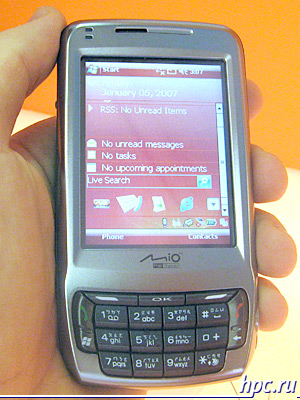 |
| Mio A702 |
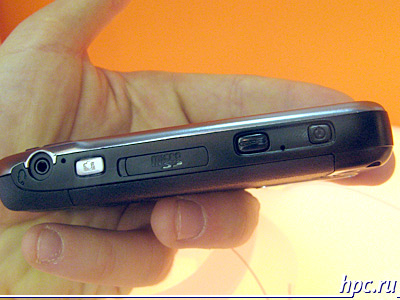 |
| Mio A702: headphone jack, camera button, microSD-slot, the button is off |
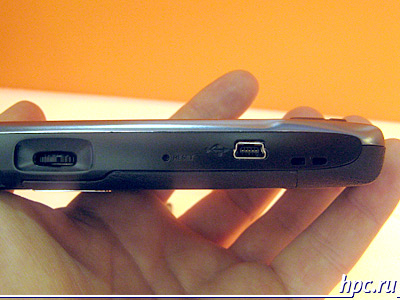 |
| Mio A702: a scroll wheel, miniUSB |
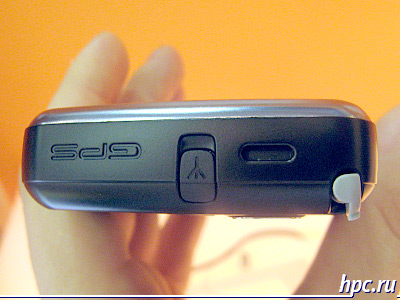 |
| Mio A702: the upper end |
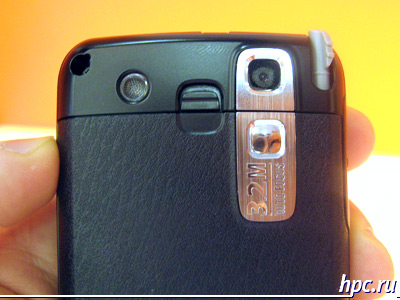 |
| Mio A702: 3,2 megapixel camera |
Navigators Acer
Acer this year also showed extremely PND, and the only navigation PDA was also demonstrated as GPS-navigator. Navigators were presented in series Acer v200, Acer p600 and Acer e300. All devices have similar features, the differences mainly in the diagonal screen size and performance. For clarity, we offer you a comparison table:
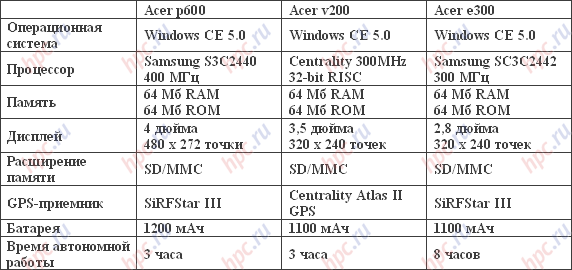 |
| PND Acer |
Naturally, all three devices are equipped with kits for installation in the car and navigation software with maps of the region in sales. In addition to its direct navigation functions, PND Acer can listen to music through the built-in speakers or through headphones and view digital photos. The older model Acer p600 is equipped with a Bluetooth-adapter and can be used as a handsfree device.Management navigators by means of a fairly large keys and touch screen, sensor, by the way, adapted to work with your fingers and provides a confident recognition clicks.
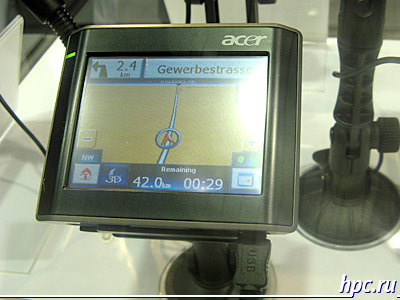 |
| Acer v200 |
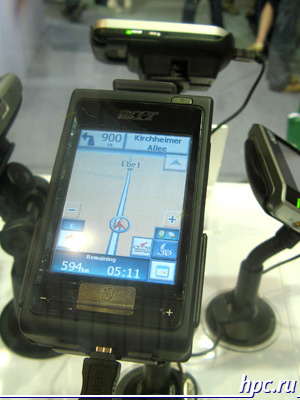 |
| Acer e300 |
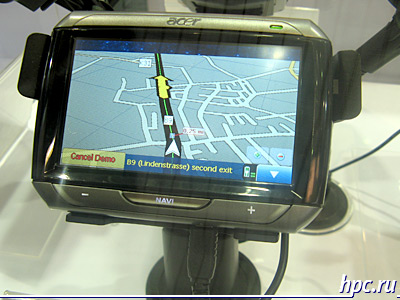 |
| Acer p600 |
Does not lag behind in features and navigation PDA - Acer c500. The model is based on the processor Samsung S3C2442 c 300 MHz, built-in memory Standard - 64 MB RAM and 128 MB ROM, memory can be supplemented with cards SD / MMC, 2.8-inch diagonal display, 320 x 240 pixels. From wireless communications present Bluetooth and Wi-Fi 802.11 b / g. For navigation capabilities meets GPS-module SiRFStar. Powered Pocket PC operating system Windows Mobile 5. Depending on the region's sales Acer c500 comes with different navigation software in Europe, as a rule, CoPilot, with respect to the Russian market clarity yet.
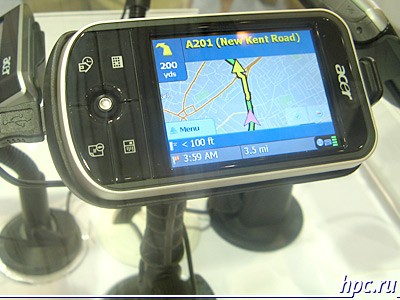 |
| Acer c500 |
And it's almost all PDAs and smartphones Computex 2007 that was worth mentioning. In the last part of our extensive reportage we will tell you about the new UMPC and compact computers, and while a little distracted.
Compal IBX10
UMD - Ultra Mobile Device, the so-called vision of mobile entertainment and communication center for the company Compal. Compal UMD IBX10 occupies an intermediate position between communicators and the UMPC in all of its parameters. Does such a decision right on the user's attention? Let's face it. First of all, Compal UMD - it is rather large and weighty (280 grams) device. At the same time, considering that the UMD has a built-in slide-out keyboard and joysticks for gaming, these two parameters can not be considered a great disadvantage. Indeed, in a typical situation the device is supposed to keep two hands.
Large widescreen display with a diagonal of 4.3 inches and a resolution of 800 by 480 pixels made an excellent impression - the picture is very clear and pleasing to the eye. No extra will be an additional width and for network: 800 points - this is an application for a complete lack of horizontal scrolling.
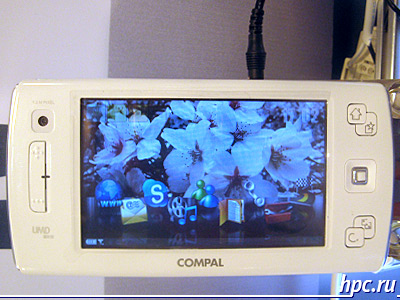 |
Built-in (absent in the exhibition copies) GPS-module, of course, write in the active UMD. The navigation program should also like 256 MB RAM, 390 MB available Flash memory and 532 MHz Freescale processor. These options will run on UMD demanding games. With the communications module is also ok - Wi-Fi, Bluetooth 2.0, GSM / WCDMA modules. An essential part of the weight UMD is the mass of the battery, which the developer must be sufficient for 5 hours on the Internet. In short, everything would be fine. Unfortunately, the build quality Compal IBX10 leaves much to be desired. The keyboard hangs out with respect to the upper part, large and uneven gaps in the folded position. Between the base parts, even from afar noticeable gap somehow kosenko each other assembled. Fuzzy keyboard, joystick and the left switch to hang. In general, there are many things which can still work. Samples of the stands gave the impression of engineering copies, although representatives Compal indicated that it is almost serial machines.
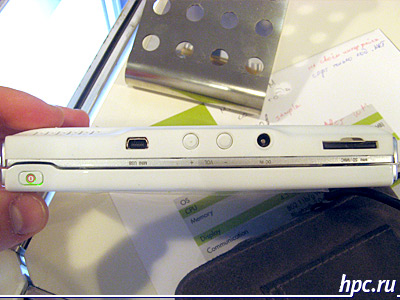 |
Another negative - the decision to use the operating system Windows CE. NET 5.0. That is, UMD turns out quite closed "thing in itself", if to install and run additional programs will require additional efforts or modifications. In fact, the scope of UMD, in this case narrows for most users to set programs that are installed at the factory. Typically, CE. NET is used in specialized devices, such as car navigation and embedded products. Exit Compal UMD market will be the end of 2007, the estimated final price abroad may be about 500 USD.
Tablet for taking notes
This year, there were cheap (about 100-150 USD) solutions for converting handwritten notes into digital format. It is light and thin plates with some memory, and depending on the version with a different set of controls. The principle is simple - are consolidating on the tablet sheet or stack of paper, right on the surface of which draw a special stylus, which is a combination of traditional pen and an electromagnetic stylus. The impact of the latter and takes the tablet. As a result, we get two copies of the notes: the first on paper, the second in memory of the tablet where you can reset the image on the computer.
Range of models and possibilities is quite large - the manufacturers offer plates with the functions of real-time connected to the PC mode, memory cards, with the possibilities of the recorder and mp3-player (than not the solution for the student?), Changing the pen color, with a wireless data exchange and so on.
Digital Microscope
Another interesting solution - a digital microscope with a magnification of 50 and 200 times. The principle is simple again - in a small cylindrical body hidden illumination and a CMOS sensor 300,000 pixels. Rotate the control of the ring induced focus and adjust the degree of magnification using aspheric lenses. Image in real time is transmitted via a USB port on a desktop computer, where you can make a screenshot or record video. Very clear and pleasing to malootvetstvennyh tasks or for training purposes.
Matrix LCD display for sunlight
And finally a few words about the technology Trio-LCD, which allows no large structural changes to get a traditional LCD screen to work well under the powerful general illumination, for example, on a sunny day at the beach. According to the technology Trio-LCD between illumination and LCD matrix is required to install an additional layer (or replace the standard) from a special polymer that is transparent in the direction of illumination to the matrix, but it is reflective on the other side. That is, the sun's rays will be reflected by this additional layer and will work as a backlight.
The most interesting thing that the manufacturer can arrange an upgrade of standard screens party devices from the pack of 10. That is, the matrix can be improved quite different manufacturers, but only in conditions of service. Of course, the official hardware warranty in this case is lost. The authors, translation:











